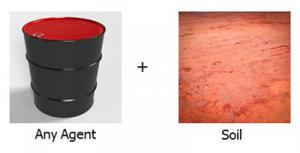Toxic chemicalsTransforming deadly chemicals into harmless dirt
Destroying bulk stores of chemical warfare agents is a challenge for the U.S. and international community. Current methods of eradication, such as incineration or hydrolysis, are not fully agnostic, require significant amounts of water and create hazardous waste that requires further processing. DARPA’s Agnostic Compact Demilitarization of Chemical Agents (ACDC) program recently awarded two contracts to develop prototypes of a transportable disposal system able to convert dangerous chemicals into safe output, such as harmless soil, using minimal consumables and creating no hazardous waste.

Deadly to harmless is the goal // Source: darpa.mil
DARPA’s Agnostic Compact Demilitarization of Chemical Agents (ACDC) program recently awarded two contracts to develop prototypes of a transportable disposal system able to convert dangerous chemicals into safe output, such as harmless soil, using minimal consumables and creating no hazardous waste. If successful, the system could be used to safely destroy chemical warfare agent stockpiles on site without having to transport the highly toxic chemicals to a remote location for processing. The approaches could also ultimately find application in a variety of industrial chemical neutralization and clean-up efforts. The awardees are Southwest Research Institute (SwRI), San Antonio, Texas, and SRI International, Menlo Park, California.
DARPA notes that destroying bulk stores of chemical warfare agents is a challenge for the U.S. and international community. Current methods of eradication, such as incineration or hydrolysis, are not fully agnostic, require significant amounts of water and create hazardous waste that requires further processing. And the logistics required to transport large stockpiles from storage to a disposal site can be risky and expensive. ACDC aims to develop a “one size fits all” technology that would work on any chemical, without requiring water or creating large amounts of waste for post-processing.
If the ACDC program is a success, it could radically streamline logistics requirements for destroying chemical weapons, according to Cheryl Lynn Maggio of the Defense Department’s Joint Program Executive Office for Chemical and Biological Defense, where she serves as director of research and technology in the office responsible for elimination of chemical weapons. “We are very interested in the new technologies DARPA is pursuing in the ACDC program, which could enable environmentally safe, cost-effective onsite destruction of chemical warfare agents anywhere in the world.”
The challenges associated with today’s chemical destruction methods are not widely appreciated in people’s everyday lives, but were overwhelmingly apparent to those who were tasked with the international effort to destroy Syrian chemical weapons in 2014. The international community finally agreed to transport the stockpile from Syria for destruction at sea aboard the U.S. MV Cape Ray. “We were able to successfully and safely neutralize those chemical weapons on the Cape Ray using hydrolysis, but the logistical and other challenges were immense,” said Julia Limage of the Office of the Chief Scientist, Defense Threat Reduction Agency, who served as liaison officer on the ship during preparations for the chemical destruction process. Among those challenges, Limage said, were building what amounted to a customized floating neutralization lab able to operate on the high seas, capable of withstanding the potentially destabilizing effects of chemical drum movements and shifting fluids in the massive tanks used in the neutralization process. In addition, hazardous waste from the process had to be transported to several countries for post-processing and final destruction. Developing a deployable system that neutralizes dangerous chemicals and chemical weapons without creating hazardous waste as a by-product would have a major positive impact on U.S. and international elimination efforts, Limage said.
Under the ACDC program, SwRI will develop a field-deployable, automated process to destroy toxic industrial compounds. The company’s approach combines a commercially available reforming-engine technology that, along with local soil, can convert organic molecules to non-hazardous components. The engine is designed such that, as part of the destruction process, the organic molecules act as a fuel and efficiently generate recoverable energy that can be converted to electricity. The SwRI process is agnostic to the chemical to be degraded, and is a much greener process than either conventional hydrolysis or incineration, both of which are logistically intensive and require subsequent secondary treatment of large amounts of hazardous waste.
SRI International has partnered with Parsons Corporation and MarqMetrix, Inc., to develop a self-contained, transportable chemical destruction system that also relies on locally available resources. SRI plans to use a high-energy plasma technology to combust organic molecules, with built-in scavenging of reaction byproducts in the same reactor. A strong focus of the SRI approach is real-time characterization of reactor output, as well as development of process-control strategies to ensure that waste is reprocessed for complete destruction and conversion efficiencies of greater than 99.9999 percent.
“Both performers bring not only deep expertise in relevant chemistries but also, importantly, truly unique methodologies to address a potentially wide spectrum of chemical neutralization challenges,” said Tyler McQuade, DARPA program manager. “The desired outcome from the neutralization process is environmentally safe material — fertilized soil. Most toxins are produced from safe natural materials in the first place, so we want to put them back into their original harmless state.”
DARPA says that performers in the ACDC program are in the early stages of demonstrating that their proposed approaches are viable methods to destroy small organic molecules. Within six months, each group hopes to demonstrate 99 percent conversion to non-hazardous output.
